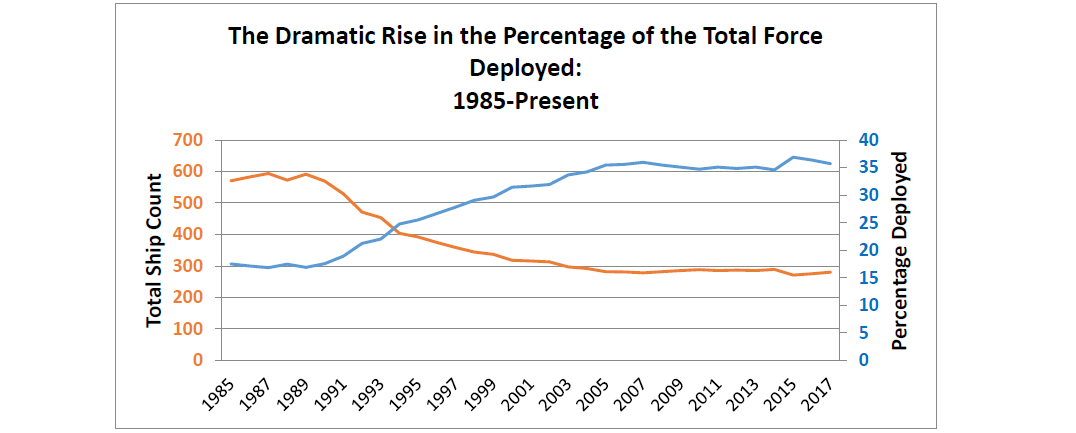U.S. Navy Releases High-Level Readiness Review
On Thursday, the U.S. Navy released its long-anticipated Strategic Readiness Review, an independent high-level study of surface force safety culture and management. Secretary of the Navy Richard Spencer ordered the strategic review in the wake of the deadly collisions involving the USS Fitzgerald and USS John S. McCain earlier this year, and the study parallels a separate operational inquiry conducted by the Department of the Navy.
The review examined stresses on the surface force due to operational culture, budget limitations, accountability structures and risk management. It also considered stresses from an increasing rate of operational tasking: the fleet’s size is half of what it was in 1989, but the percentage of its units that are deployed at a given time has doubled (below).

The report placed particular emphasis on the risks created by the surface fleet’s long-term deviation from its own standards in order to meet current demands – a practice that the panel found to be "institutionalized" in day-to-day operations.
"Whether driven by operational urgency, the demands of the mission, or the needs of the Navy, these [deviations] culminated in a Navy culture replete with examples of accepting 'good enough' for the moment rather than the imperative of what is vital for the future until the organization could no longer identify 'what right looks like,'" the panel wrote. The finding mirrors the Navy's own conclusions about training standards at 7th Fleet, which were consistently allowed to lapse in favor of meeting operational demands in the Western Pacific. Both USS Fitzgerald and USS McCain had been operating without multiple training certifications for months when the casualties occurred.
The panel also consulted with industry, including merchant vessel operators Carnival, Crowley and Maersk, to gain insight on how to create and maintain a strong safety culture. In conversations with maritime executives, reviewers found that proactive safety management requires a learning-from-mistakes culture that is designed to encourage reporting – something that is only possible with the full commitment of top leaders. "Employees had to trust that organizational leadership would focus on fixing the systemic contributors to mishaps or unsafe practices rather than searching for the personal failures that lead up to an accident or incident," the panel wrote. If an organization keeps a "zero-defect" mentality that focuses on penalizing individuals’ mistakes, they suggest, employees will not report leading indicators of developing problems.
The panel gave four policy recommendations for improving readiness and averting future casualties:
1. Re-establish Readiness as a Priority: The ships, aircraft, and men and women of the Navy are finite resources. Those who man our ships are limited in the amount of time they have to perform equipment maintenance and build their warfighting skills. Those tasks must be on equal footing with “answering the bell” to peacetime presence demands. . . . It takes time and repetition to master tasks such as navigation in heavily trafficked waters, alongside replenishment, anchoring, and making an approach to a pier. Failure to commit to readiness as a priority will inevitably reproduce the mistakes of the past.
2. Match Supply and Demand: A significant reduction in the number of ships available, combined with an increasing operational tempo, forced the Navy to make hard decisions regarding the balance between operations and readiness. In that environment, a culture evolved that normalized the deviance associated with prioritizing current operations at the expense of future readiness. . . . Leaders, both civilian and military, must accept that to restore the readiness of the fleet and eliminate the culture that normalizes deviation, the Navy will sometimes have to say no, ultimately meaning less short-term presence worldwide.
3. Establish Clear Command and Control Relationships: Reorganizations within and above the Navy have changed force generation and employment processes and procedures. Cumulative changes have created redundancies, overlapping responsibilities, inconsistencies, and ambiguities that undid tightly aligned responsibility, authority, and accountability standards. These reorganizations led to a growth in headquarters with misaligned authorities, complicated command and control responsibilities, and diffuse accountability structures. . . .The Strategic Review recommends a “clean sheet” review of Navy administrative organization and offers a revised organizational construct and authorities for managing Navy forces.
4. Become a True Learning Organization: Military operations are inherently risky. Human error will always exist; equipment will always fail; the strategic environment and adversaries will change. Organizational systems must be designed to anticipate and mitigate against these realities. Individual accountability for human error, alone, is insufficient and hollow. It rarely produces lasting organizational effects or betters the affected individuals in the absence of accompanying institutional accountability that addresses underlying systemic contributors to the event. Independent checks and balances must be in place and continually evaluated, thereby guarding against the “normalization-of-deviation” that has been the thread running throughout the Strategic Review.
The full independent review may be found here, and the Navy's earlier internal report into the factors behind the incidents at 7th Fleet may be found here.
